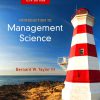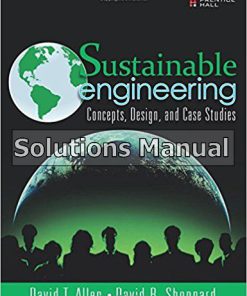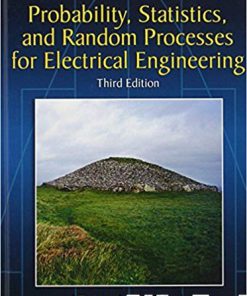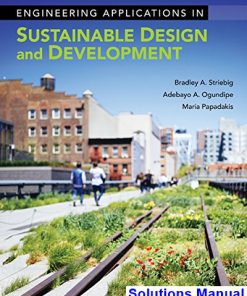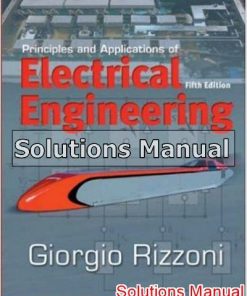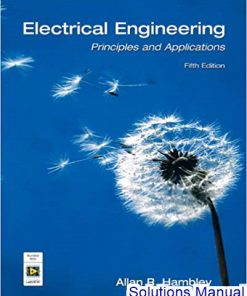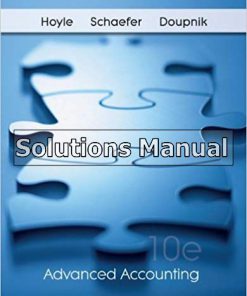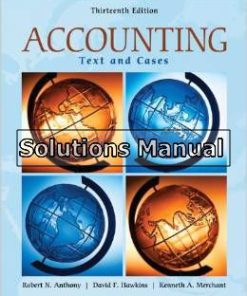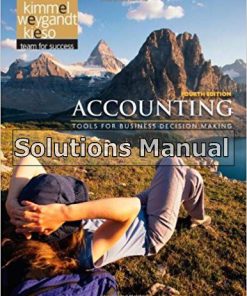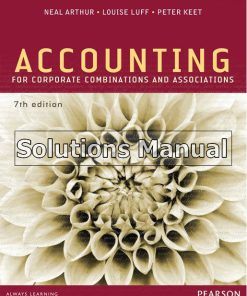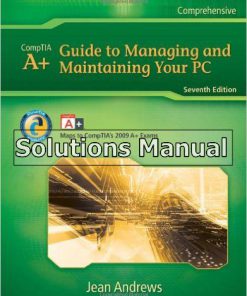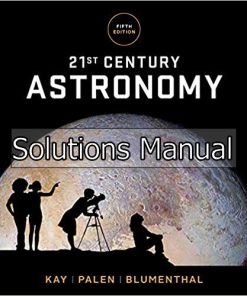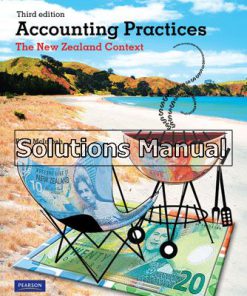Electrical Engineering Concepts and Applications 1st Edition Reza Zekavat Solutions Manual
$50.00 Original price was: $50.00.$26.50Current price is: $26.50.
Electrical Engineering Concepts and Applications 1st Edition Reza Zekavat Solutions Manual.
This is completed downloadable of Electrical Engineering Concepts and Applications 1st Edition Reza Zekavat Solutions Manual
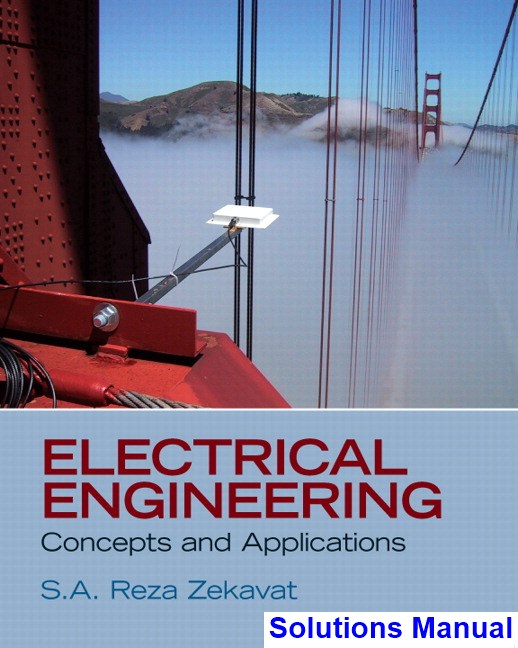
Product Details:
ISBN 10: 0132539187
ISBN 13: 9780132539180
Author: Reza Zekavat
Electrical Engineering: Concepts and Applications is the result of a multi-disciplinary effort at Michigan Technological University to create a new curriculum that is attractive, motivational, and relevant to students by creating many application-based problems; and provide the optimal level of both range and depth of coverage of EE topics in a curriculum package.
Table of Content:
Acknowledgements xix
Chapter 1 Why Electrical Engineering? 1
1.1 Introduction 1
1.2 Electrical Engineering and a Successful Career 2
1.3 What Do You Need to Know about EE? 2
1.4 Real Career Success Stories 3
1.5 Typical Situations Encountered on the Job 4
1.5.1 On-the-Job Situation 1: Active Structural Control 4
1.5.2 On-the-Job Situation 2: Chemical Process Control 6
1.5.3 On-the-Job Situation 3: Performance of an Off-Road Vehicle Prototype 8
Further Reading 12
Chapter 2 Fundamentals of Electric Circuits 13
2.1 Introduction 13
2.2 Charge and Current 15
2.3 Voltage 17
2.4 Respective Direction of Voltage and Current 18
2.5 Kirchhoff’s Current Law 18
2.6 Kirchhoff’s Voltage Law 22
2.7 Ohm’s Law and Resistors 27
2.7.1 Resistivity of a Resistor 29
2.7.2 Nonlinear Resistors 32
2.7.3 Time-Varying Resistors 32
2.8 Power and Energy 32
2.8.1 Resistor-Consumed Power 36
2.9 Independent and Dependent Sources 38
2.10 Analysis of Circuits Using PSpice 42
Bias Point Analysis 45
Time Domain (Transient) Analysis 46
Copy the Simulation Plot to the Clipboard to Submit Electronically 47
2.11 What Did You Learn? 53
Problems 54
Chapter 3 Resistive Circuits 61
3.1 Introduction 61
3.2 Resistors in Parallel and Series and Equivalent Resistance 62
3.3 Voltage and Current Division/Divider Rules 71
3.3.1 Voltage Division 71
3.3.2 Current Division 74
3.4 Nodal and Mesh Analysis 81
3.4.1 Nodal Analysis 81
3.4.2 Mesh Analysis 88
3.5 Special Conditions: Super Node 92
3.6 Thévenin/Norton Equivalent Circuits 99
3.6.1 Source Transformation 108
3.7 Superposition Principle 112
3.8 Maximum Power Transfer 118
3.9 Analysis of Circuits Using PSpice 122
3.10 What Did You Learn? 125
Problems 126
Chapter 4 Capacitance and Inductance 135
4.1 Introduction 135
4.2 Capacitors 136
4.2.1 The Relationship Between Charge, Voltage, and Current 138
4.2.2 Power 140
4.2.3 Energy 140
4.3 Capacitors in Series and Parallel 141
4.3.1 Series Capacitors 141
4.3.2 Parallel Capacitance 142
4.4 Inductors 147
4.4.1 The Relationship Between Voltage and Current 147
4.4.2 Power and Stored Energy 148
4.5 Inductors in Series and Parallel 149
4.5.1 Inductors in Series 150
4.5.2 Inductors in Parallel 150
4.6 Applications of Capacitors and Inductors 152
4.6.1 Fuel Sensors 152
4.6.2 Vibration Sensors 153
4.7 Analysis of Capacitive and Inductive Circuits Using PSpice 156
4.8 What Did You Learn? 158
Problems 159
Chapter 5 Transient Analysis 164
5.1 Introduction 164
5.2 First-Order Circuits 165
5.2.1 RC Circuits 165
5.2.2 RL Circuits 179
5.3 DC Steady State 186
5.4 DC Steady State for Capacitive–Inductive Circuits 188
5.5 Second-Order Circuits 189
5.5.1 Series RLC Circuits with a DC Voltage Source 189
5.5.2 Parallel RLC Circuits with a DC Voltage Source 196
5.6 Transient Analysis with Sinusoid Forcing Functions 198
5.7 Using PSpice to Investigate the Transient Behavior of RL and RC Circuits 201
5.8 What Did You Learn? 207
Problems 208
Chapter 6 Steady-State AC Analysis 215
6.1 Introduction: Sinusoidal Voltages and Currents 215
6.1.1 Root-Mean-Square (rms) Values (Effective Values) 220
6.1.2 Instantaneous and Average Power 221
6.2 Phasors 222
6.2.1 Phasors in Additive or (Subtractive) Sinusoids 224
6.3 Complex Impedances 225
6.3.1 The Impedance of a Resistor 225
6.3.2 The Impedance of an Inductor 225
6.3.3 The Impedance of a Capacitor 226
6.3.4 Series Connection of Impedances 228
6.3.5 Parallel Connection of Impedances 229
6.4 Steady-State Circuit Analysis Using Phasors 231
6.5 Thévenin and Norton Equivalent Circuits with Phasors 239
6.5.1 Thévenin Equivalent Circuits with Phasors 239
6.5.2 Norton Equivalent Circuits with Phasors 240
6.6 AC Steady-State Power 243
6.6.1 Average Power 245
6.6.2 Power Factor 246
6.6.3 Reactive Power 246
6.6.4 Complex Power 247
6.6.5 Apparent Power 249
6.6.6 Maximum Average Power Transfer 252
6.6.7 Power Factor Correction 254
6.7 Steady-State Circuit Analysis Using PSpice 259
6.8 What Did You Learn? 265
Problems 267
Chapter 7 Frequency Analysis 274
7.1 Introduction 274
7.2 First-Order Filters 276
7.2.1 Transfer Functions 276
7.3 Low-Pass Filters 276
7.3.1 Magnitude and Phase Plots 280
7.3.2 Decibels 280
7.3.3 Bode Plot 282
7.4 High-Pass Filters 285
7.4.1 Cascaded Networks 287
7.5 Second-Order Filters 289
7.5.1 Band-Pass Filters 289
7.5.2 Band-Stop Filters 291
7.6 MATLAB Applications 293
7.7 Frequency Response Analysis Using PSpice 300
7.8 What Did You Learn? 309
Problems 310
Chapter 8 Electronic Circuits 316
8.1 Introduction 316
8.2 P-Type and N-Type Semiconductors 317
8.3 Diodes 319
8.3.1 Diode Applications 323
8.3.2 Different Types of Diodes 329
8.3.3 AC-to-DC Converter 335
8.4 Transistors 338
8.4.1 Bipolar Junction Transistor 338
8.4.2 Transistor as an Amplifier 339
8.4.3 Transistors as Switches 356
8.4.4 Field-Effect Transistors 357
8.4.5 Design of NOT Gates Using NMOS Only for High-Density Integration 367
8.4.6 Design of a Logic Gate Using CMOS 369
8.5 Operational Amplifiers 371
8.6 Using PSpice to Study Diodes and Transistors 377
8.7 What Did You Learn? 385
Further Reading 385
Problems 386
Chapter 9 Power Systems and Transmission Lines 395
9.1 Introduction 395
9.2 Three-Phase Systems 396
9.2.1 Introduction 396
9.2.2 Phase Sequence 398
9.2.3 Y-Connected Generators 398
9.2.4 Y-Connected Loads 398
9.2.5 Δ-Connected Loads 401
9.2.6 Δ-Star and Star-Δ Transformations 404
9.2.7 Power in Three-Phase Systems 406
9.2.8 Comparison of Star and Δ Load Connections 411
9.2.9 Advantages of Three-Phase Systems 411
9.3 Transmission Lines 412
9.3.1 Introduction 412
9.3.2 Resistance (R) 414
9.3.3 Different Types of Conductors 415
9.3.4 Inductance (L) 416
9.3.5 Capacitance 421
9.3.6 Transmission Line Equivalent Circuits 424
9.4 Using PSpice to Study Three-Phase Systems 432
9.5 What Did You Learn? 435
Further Reading 435
Problems 436
Chapter 10 Fundamentals of Logic Circuits 440
10.1 Introduction 440
10.2 Number Systems 442
10.2.1 Binary Numbers 442
10.2.2 Hexadecimal Numbers 449
10.2.3 Octal Numbers 450
10.3 Boolean Algebra 451
10.3.1 Boolean Inversion 451
10.3.2 Boolean AND Operation 451
10.3.3 Boolean OR Operation 452
10.3.4 Boolean NAND Operation 452
10.3.5 Boolean NOR Operation 452
10.3.6 Boolean XOR Operation 452
10.3.7 Summary of Boolean Operations 452
10.3.8 Rules Used in Boolean Algebra 452
10.3.9 De Morgan’s Theorems 453
10.3.10 Commutativity Rule 454
10.3.11 Associativity Rule 454
10.3.12 Distributivity Rule 454
10.4 Basic Logic Gates 459
10.4.1 The NOT Gate 459
10.4.2 The AND Gate 460
10.4.3 The OR Gate 460
10.4.4 The NAND Gate 460
10.4.5 The NOR Gate 461
10.4.6 The XOR Gate 463
10.4.7 The XNOR Gate 463
10.5 Sequential Logic Circuits 466
10.5.1 Flip-Flops 466
10.5.2 Counter 470
10.6 Using PSpice to Analyze Digital Logic Circuits 474
10.7 What Did You Learn? 481
Reference 482
Problems 483
Chapter 11 Computer-Based Instrumentation Systems 488
11.1 Introduction 488
11.2 Sensors 489
11.2.1 Pressure Sensors 490
11.2.2 Temperature Sensors 491
11.2.3 Accelerometers 497
11.2.4 Strain-Gauges/Load Cells 498
11.2.5 Acoustic Sensors 500
11.2.6 Linear Variable Differential Transformers (LVDT) 503
11.3 Signal Conditioning 505
11.3.1 Amplifiers 505
11.3.2 Active Filters 505
11.4 Data Acquisition 511
11.4.1 Analog Multiplexer 511
11.4.2 Analog-to-Digital Conversion 511
11.5 Grounding Issues 514
11.5.1 Ground Loops 514
11.6 Using PSpice to Demonstrate a Computer-Based Instrument 516
11.7 What Did You Learn? 519
Further Reading 519
Problems 519
Chapter 12 Principles of Electromechanics 524
12.1 Introduction 524
12.2 Magnetic Fields 525
12.2.1 Magnetic Flux and Flux Intensity 526
12.2.2 Magnetic Field Intensity 527
12.2.3 The Right-Hand Rule 527
12.2.4 Forces on Charges by Magnetic Fields 528
12.2.5 Forces on Current-Carrying Wires 528
12.2.6 Flux Linkages 530
12.2.7 Faraday’s Law and Lenz’s Law 530
12.3 Magnetic Circuits 530
12.3.1 Magnetomotive Force 531
12.3.2 Reluctance 532
12.4 Mutual Inductance and Transformers 538
12.4.1 Mutual Inductance 539
12.4.2 Transformers 542
12.5 Different Types of Transformers 547
12.6 Using PSpice to Simulate Mutual Inductance and Transformers 547
12.7 What Did You Learn? 552
Problems 552
Chapter 13 Electric Machines 557
13.1 Introduction 557
13.1.1 Features of Electric Machines 558
13.1.2 Classification of Motors 558
13.2 DC Motors 559
13.2.1 Principle of Operation 559
13.2.2 Assembly of a Typical DC Motor 559
13.2.3 Operation of a DC Motor 560
13.2.4 Losses in DC Machines 561
13.3 Different Types of DC Motors 563
13.3.1 Analysis of a DC Motor 563
13.3.2 Shunt-Connected DC Motor 566
13.3.3 Separately Excited DC Motors 567
13.3.4 Permanent Magnet (PM) DC Motor 568
13.3.5 Series-Connected DC Motor 571
13.3.6 Summary of DC Motors 573
13.4 Speed Control Methods 573
13.4.1 Speed Control by Varying the Field Current 573
13.4.2 Speed Control by Varying the Armature Current 575
13.5 DC Generators 576
13.5.1 The Architecture and Principle of Operation of a DC Generator 576
13.5.2 emf Equation 577
13.6 Different Types of DC Generators 578
13.6.1 Load Regulation Characteristics of DC Generators 578
13.6.2 Separately Excited DC Generator 579
13.6.3 Shunt-Connected DC Generator 580
13.7 AC Motors 580
13.7.1 Three-Phase Synchronous Motors 581
13.7.2 Three-Phase Induction Motor 584
13.7.3 Losses in AC Machines 591
13.7.4 Power Flow Diagram for an AC Motor 591
13.8 AC Generators 592
13.8.1 Construction and Working 593
13.8.2 Winding Terminologies for the Alternator 593
13.8.3 The emf Equation of an Alternator 595
13.9 Special Types of Motors 597
13.9.1 Single-Phase Induction Motors 597
13.9.2 Stepper Motors 597
13.9.3 Brushless DC Motors 599
13.9.4 Universal Motors 600
13.10 How Is the Most Suitable Motor Selected? 602
13.11 Setup of a Simple DC Motor Circuit Using PSpice 603
13.12 What Did You Learn? 610
Further Reading 611
Problems 611
Chapter 14 Electrical Measurement Instruments 615
14.1 Introduction 615
14.2 Measurement Errors 616
14.3 Basic Measurement Instruments 619
14.3.1 An Ammeter Built Using a Galvanometer 619
14.3.2 A Voltmeter Built Using a Galvanometer 620
14.3.3 An Ohmmeter Built Using a Galvanometer 621
14.3.4 Multi-Meters 621
14.4 Time Domain and Frequency Domain 625
14.4.1 The Time Domain 625
14.4.2 The Frequency Domain 626
14.4.3 Time Domain Versus Frequency Domain 627
14.5 The Oscilloscope 628
14.6 The Spectrum Analyzer 633
14.6.1 Adjusting the Spectrum Analyzer’s Display Window 633
14.7 The Function Generator 639
14.8 What Did You Learn? 640
Problems 641
Chapter 15 Electrical Safety 646
15.1 Introduction 646
15.2 Electric Shock 646
15.2.1 Shock Effects 647
15.2.2 Shock Prevention 649
15.3 Electromagnetic Hazards 649
15.3.1 High-Frequency Hazards 649
15.3.2 Low-Frequency Hazards 651
15.3.3 Avoiding Radio Frequency Hazards 655
15.4 Arcs and Explosions 655
15.4.1 Arcs 655
15.4.2 Blasts 657
15.4.3 Explosion Prevention 657
15.5 The National Electric Code 658
15.5.1 Shock Prevention 658
15.5.2 Fire Prevention 663
15.6 What Did You Learn? 665
References 665
Problems 666
Appendix A: Solving Linear Equations 671
Appendix B: Laplace Transform 673
Appendix C: Complex Numbers 677
Selected Solutions 683
Index 687
People Also Search:
electrical engineering concepts and applications reza zekavat
electrical engineering concepts and applications 1st edition reza zekavat
electrical engineering concepts and applications 1st edition
electrical engineering concepts and applications 1st edition solution manual download pdf
electrical engineering concepts and applications 1st edition download scribd
Instant download after Payment is complete
You may also like…
Solutions Manual
Sustainable Engineering Concepts Design and Case Studies 1st Edition Allen Solutions Manual
Solutions Manual
Solutions Manual
Principles And Applications of Electrical Engineering 6th Edition Rizzoni Solutions Manual
Engineering
Engineering Applications in Sustainable Design and Development 1st Edition Striebig Solutions Manual
Solutions Manual
Essentials Of Electrical And Computer Engineering 1st Edition Kerns Solutions Manual
Solutions Manual
Principles and Applications of Electrical Engineering 5th Edition Rizzoni Solutions Manual
Solutions Manual
Electrical Engineering Principlesand And Applications 5th Edition Hambley Solutions Manual
Related products
Solutions Manual
Solutions Manual
Accounting Texts and Cases 13th Edition Anthony Solutions Manual
Solutions Manual
Solutions Manual
Solutions Manual



